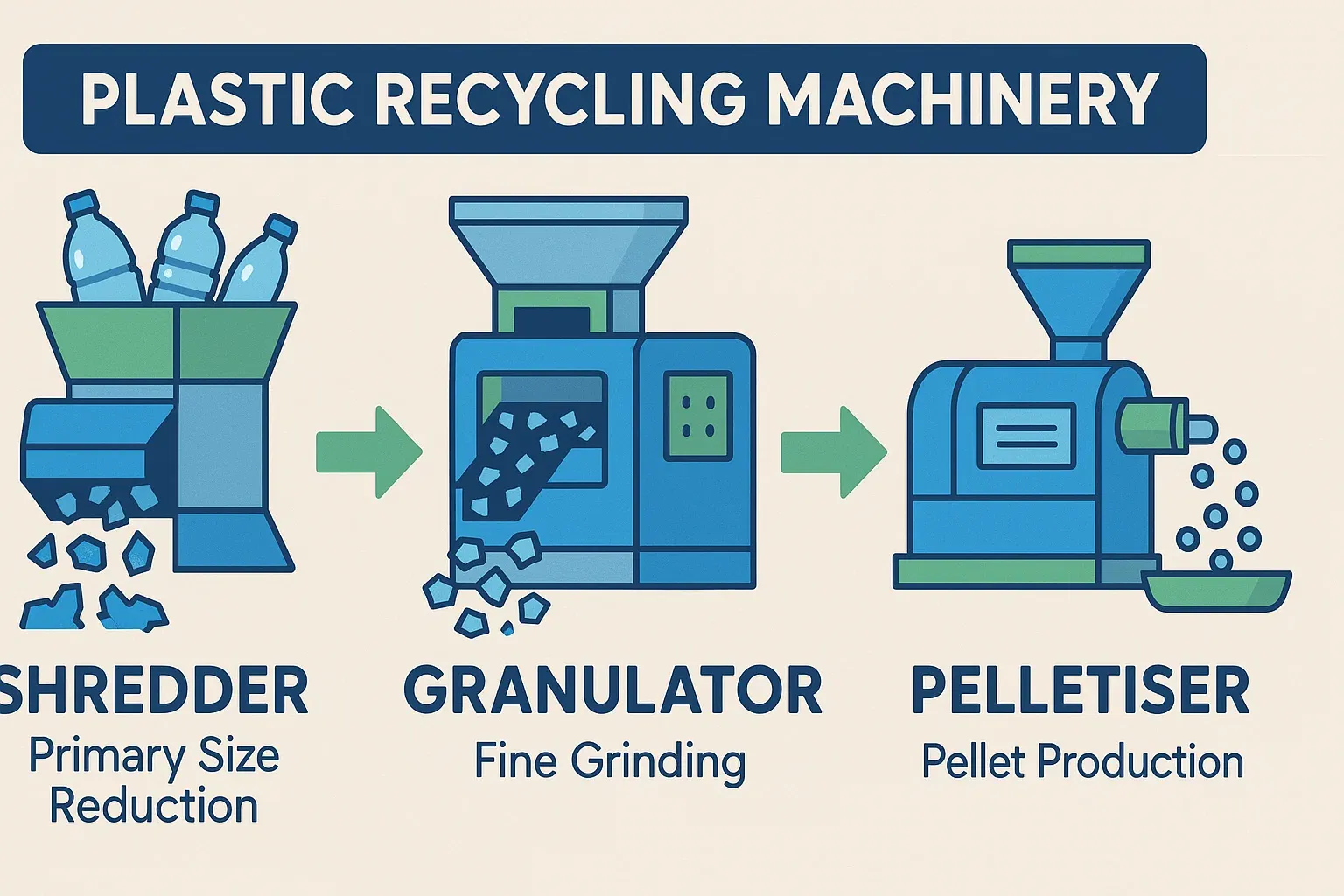Granulátory vs. drtiče vs. peletizéry: Pochopení rozdílů a synergií
V oblasti recyklace plastů jsou granulátory, drtiče a peletizéry tři běžná, ale funkčně odlišná zařízení. Jasné pochopení jejich rozdílů a vzájemného propojení je klíčové pro optimalizaci recyklačních procesů.
Drtič
Drtič se primárně používá k počátečnímu drcení velkého, objemného nebo smíšeného plastového odpadu. Obvykle využívá metody trhání, stříhání nebo úderů k výrobě větších kusů nepravidelné velikosti. Drtiče často slouží jako zařízení pro předběžné zpracování granulátorů, zejména při práci s materiály, které jsou příliš objemné nebo je obtížné je podávat přímo do násypky granulátoru. Hlavním cílem je zmenšit objem materiálu pro snazší následnou manipulaci s menším důrazem na jednotnost konečné částice.
Granulátor
Granulátor, jak název napovídá, používá vysokorychlostní rotující nože k jemnému řezání a rozmělňování plastů, čímž vznikají menší, relativně rovnoměrné částice nebo vločky (často nazývané drť). Tato drť může být přímo znovu použita ve výrobě nebo sloužit jako vstupní surovina pro peletizátor.
Peletizér
Peletizér je obvykle umístěn na konci recyklační linky. Vezme vyčištěný a drcený (případně granulovaný) plast, roztaví ho a protlačí ho přes lisovací hlavu do pramenů. Tyto prameny jsou poté řezány peletizační jednotkou (např. vodním kruhem, vzduchem chlazenou, podvodní) do jednotných, prodejních plastových pelet. Tyto pelety mají konzistentní tvar, velikost a objemovou hmotnost, což usnadňuje jejich skladování, přepravu a použití v následných procesech lisování plastů.
Synergie v recyklačních linkách
Tyto tři typy zařízení mohou v recyklační lince synergicky fungovat. Typický proces může zahrnovat: velké odpadní kusy nejprve vstupují do drtiče pro hrubé drcení a poté jsou přepravovány do granulátoru pro jemné mletí. Výsledný drcený materiál se po promytí a vysušení přivádí do peletizátoru, kde se roztaví, extruduje a nařeže na finální plastové pelety. Některé integrované systémy dokonce kombinují funkce drcení, podávání a extruze (peletizace) v jednom kroku.
Optimální konfigurace recyklační linky (např. drtič → granulátor → peletizér vs. granulátor → peletizér) je vysoce závislá na formě a objemu vstupního materiálu, stejně jako na specifikacích požadovaných pro konečný produkt. Neexistuje jediné „nejlepší“ pořadí. Volba zařízení a jeho pořadí je strategickým rozhodnutím založeným na charakteristikách materiálu a cílech zpracování, což je klíčové pro inženýry navrhující recyklační linky.
Důsledky nedorozumění v roli vybavení
Záměna odlišných rolí drtičů, granulátorů a peletizátorů může vést k neefektivnímu zpracování, zvýšené spotřebě energie a nižší kvalitě recyklovaných materiálů, což má v konečném důsledku dopad na návratnost investic. Například použití granulátoru ke zpracování velmi velkých nebo tvrdých materiálů, které jsou vhodnější pro drtič, povede k nadměrnému opotřebení nožů a sít, častému ucpávání a přetížení motoru. Podobně je nereálné očekávat, že granulovaný drť bude mít stejné fyzikální vlastnosti jako peletizované granule. Jasné rozlišení funkcí tohoto zařízení pomáhá kupujícím činit informovaná investiční rozhodnutí a umožňuje inženýrům navrhovat efektivní recyklační systémy.



